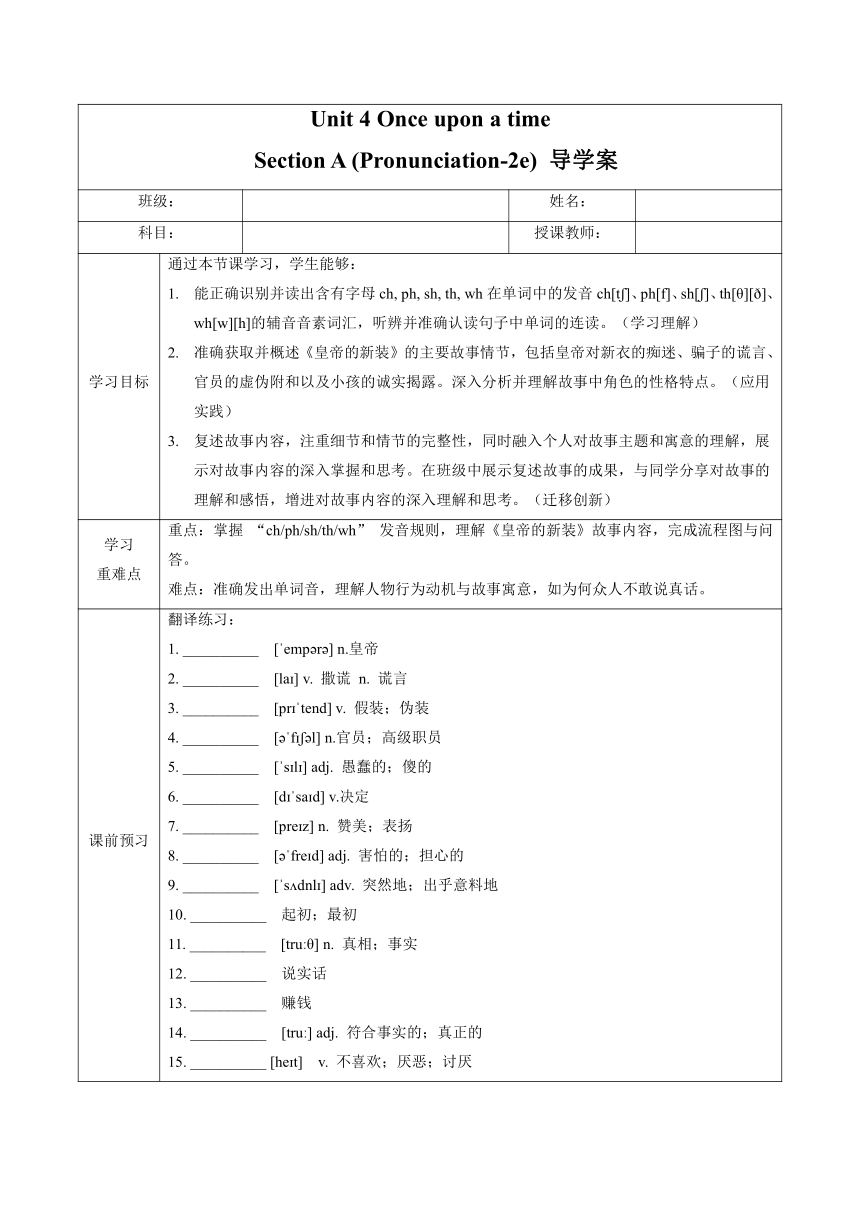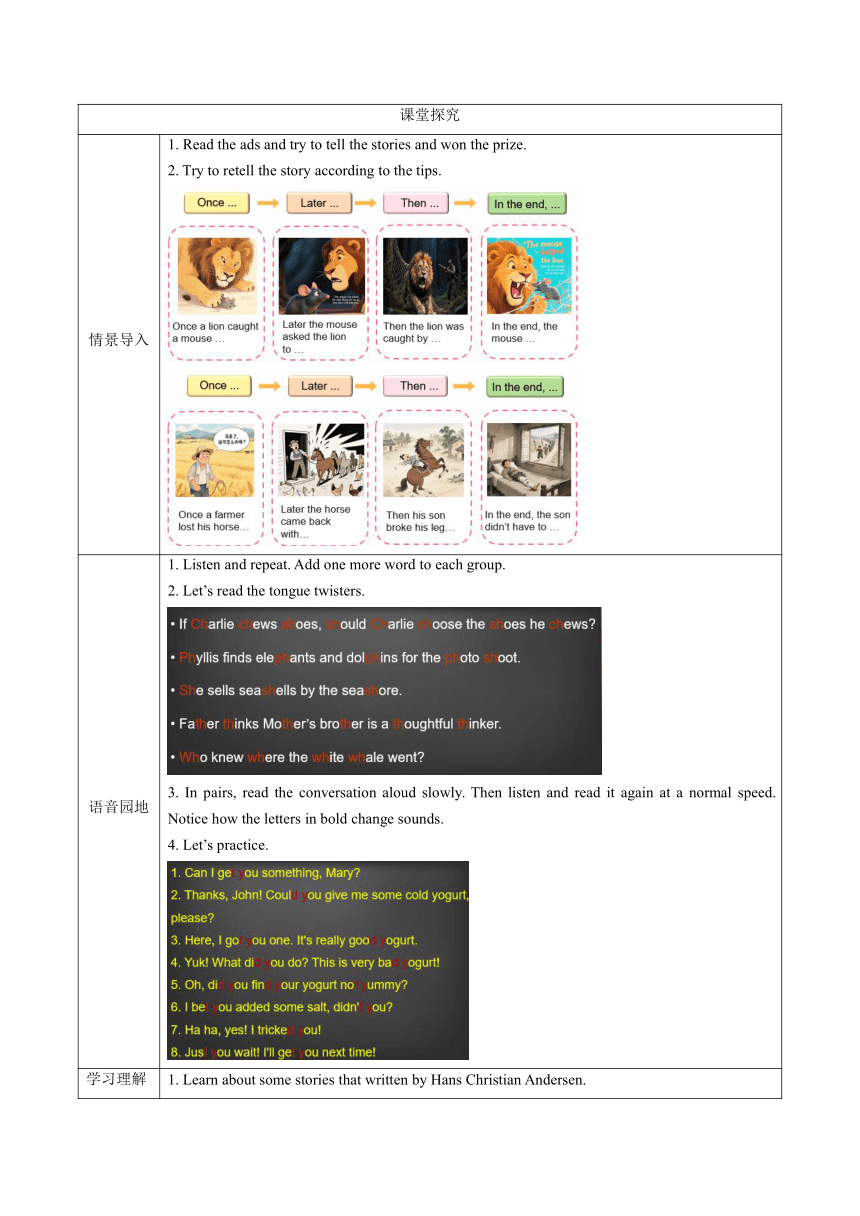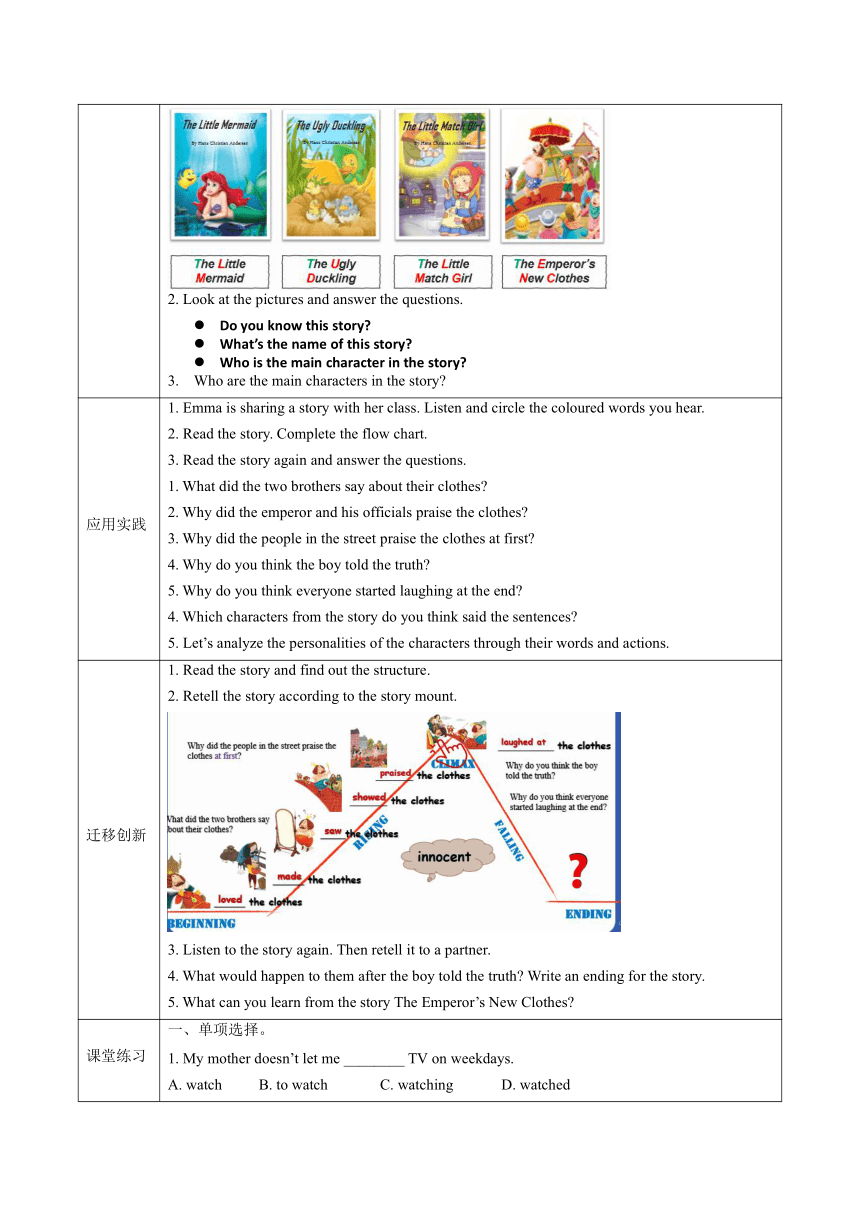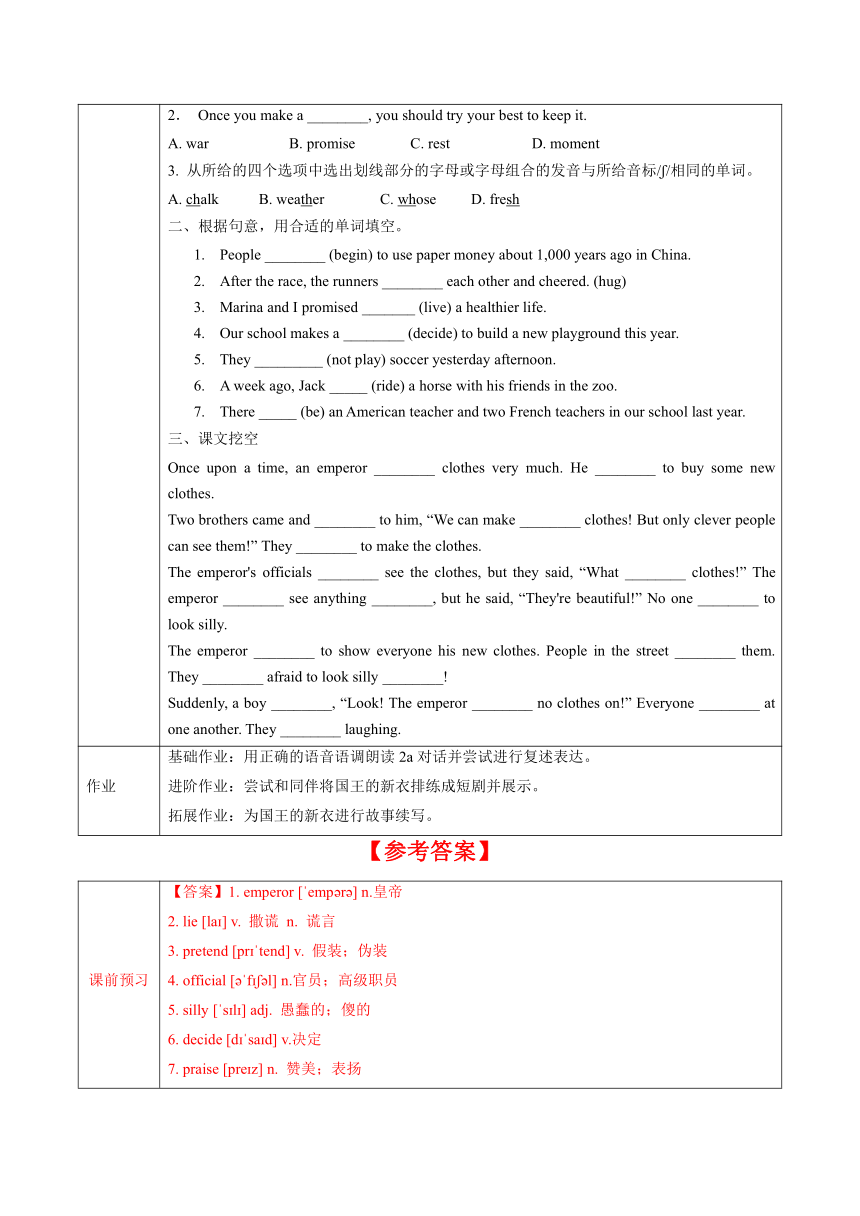Unit 4 Once upon a Time 第2课时 Section A (Pronunciation-2e)(导学案)-英语鲁教版五四学制2024七年级上册
文档属性
| 名称 | Unit 4 Once upon a Time 第2课时 Section A (Pronunciation-2e)(导学案)-英语鲁教版五四学制2024七年级上册 |  | |
| 格式 | docx | ||
| 文件大小 | 2.3MB | ||
| 资源类型 | 教案 | ||
| 版本资源 | 鲁教版 | ||
| 科目 | 英语 | ||
| 更新时间 | 2025-07-23 17:18:52 | ||
图片预览




文档简介
Unit 4 Once upon a time Section A (Pronunciation-2e) 导学案
班级: 姓名:
科目: 授课教师:
学习目标 通过本节课学习,学生能够: 能正确识别并读出含有字母ch, ph, sh, th, wh在单词中的发音ch[t ]、ph[f]、sh[ ]、th[θ][ ]、wh[w][h]的辅音音素词汇,听辨并准确认读句子中单词的连读。(学习理解) 准确获取并概述《皇帝的新装》的主要故事情节,包括皇帝对新衣的痴迷、骗子的谎言、官员的虚伪附和以及小孩的诚实揭露。深入分析并理解故事中角色的性格特点。(应用实践) 复述故事内容,注重细节和情节的完整性,同时融入个人对故事主题和寓意的理解,展示对故事内容的深入掌握和思考。在班级中展示复述故事的成果,与同学分享对故事的理解和感悟,增进对故事内容的深入理解和思考。(迁移创新)
学习 重难点 重点:掌握 “ch/ph/sh/th/wh” 发音规则,理解《皇帝的新装》故事内容,完成流程图与问答。 难点:准确发出单词音,理解人物行为动机与故事寓意,如为何众人不敢说真话。
课前预习 翻译练习: 1. __________ [ emp r ] n.皇帝 2. __________ [la ] v. 撒谎 n. 谎言 3. __________ [pr tend] v. 假装;伪装 4. __________ [ f l] n.官员;高级职员 5. __________ [ s l ] adj. 愚蠢的;傻的 6. __________ [d sa d] v.决定 7. __________ [pre z] n. 赞美;表扬 8. __________ [ fre d] adj. 害怕的;担心的 9. __________ [ s dnl ] adv. 突然地;出乎意料地 10. __________ 起初;最初 11. __________ [tru θ] n. 真相;事实 12. __________ 说实话 13. __________ 赚钱 14. __________ [tru ] adj. 符合事实的;真正的 15. __________ [he t] v. 不喜欢;厌恶;讨厌
课堂探究
情景导入 1. Read the ads and try to tell the stories and won the prize. 2. Try to retell the story according to the tips.
语音园地 1. Listen and repeat. Add one more word to each group. 2. Let’s read the tongue twisters. 3. In pairs, read the conversation aloud slowly. Then listen and read it again at a normal speed. Notice how the letters in bold change sounds. 4. Let’s practice.
学习理解 1. Learn about some stories that written by Hans Christian Andersen. 2. Look at the pictures and answer the questions. Do you know this story What’s the name of this story Who is the main character in the story 3. Who are the main characters in the story
应用实践 1. Emma is sharing a story with her class. Listen and circle the coloured words you hear. 2. Read the story. Complete the flow chart. 3. Read the story again and answer the questions. 1. What did the two brothers say about their clothes 2. Why did the emperor and his officials praise the clothes 3. Why did the people in the street praise the clothes at first 4. Why do you think the boy told the truth 5. Why do you think everyone started laughing at the end 4. Which characters from the story do you think said the sentences 5. Let’s analyze the personalities of the characters through their words and actions.
迁移创新 1. Read the story and find out the structure. 2. Retell the story according to the story mount. 3. Listen to the story again. Then retell it to a partner. 4. What would happen to them after the boy told the truth Write an ending for the story. 5. What can you learn from the story The Emperor’s New Clothes
课堂练习 一、单项选择。 1. My mother doesn’t let me ________ TV on weekdays. A. watch B. to watch C. watching D. watched 2. Once you make a ________, you should try your best to keep it. A. war B. promise C. rest D. moment 3. 从所给的四个选项中选出划线部分的字母或字母组合的发音与所给音标/ /相同的单词。 A. chalk B. weather C. whose D. fresh 二、根据句意,用合适的单词填空。 People ________ (begin) to use paper money about 1,000 years ago in China. After the race, the runners ________ each other and cheered. (hug) Marina and I promised _______ (live) a healthier life. Our school makes a ________ (decide) to build a new playground this year. They _________ (not play) soccer yesterday afternoon. A week ago, Jack _____ (ride) a horse with his friends in the zoo. There _____ (be) an American teacher and two French teachers in our school last year. 三、课文挖空 Once upon a time, an emperor ________ clothes very much. He ________ to buy some new clothes. Two brothers came and ________ to him, “We can make ________ clothes! But only clever people can see them!” They ________ to make the clothes. The emperor's officials ________ see the clothes, but they said, “What ________ clothes!” The emperor ________ see anything ________, but he said, “They're beautiful!” No one ________ to look silly. The emperor ________ to show everyone his new clothes. People in the street ________ them. They ________ afraid to look silly ________! Suddenly, a boy ________, “Look! The emperor ________ no clothes on!” Everyone ________ at one another. They ________ laughing.
作业 基础作业:用正确的语音语调朗读2a对话并尝试进行复述表达。 进阶作业:尝试和同伴将国王的新衣排练成短剧并展示。 拓展作业:为国王的新衣进行故事续写。
【参考答案】
课前预习 【答案】1. emperor [ emp r ] n.皇帝 2. lie [la ] v. 撒谎 n. 谎言 3. pretend [pr tend] v. 假装;伪装 4. official [ f l] n.官员;高级职员 5. silly [ s l ] adj. 愚蠢的;傻的 6. decide [d sa d] v.决定 7. praise [pre z] n. 赞美;表扬 8. afraid [ fre d] adj. 害怕的;担心的 9. suddenly [ s dnl ] adv. 突然地;出乎意料地 10. at first 起初;最初 11. truth [tru θ] n. 真相;事实 12. tell the truth 说实话 13. make money 赚钱 14. true [tru ] adj. 符合事实的;真正的 15. hate[he t] v. 不喜欢;厌恶;讨厌
课堂探究
情景导入 1. Read the ads and try to tell the stories and won the prize. 2. Try to retell the story according to the tips.
语音园地 1. Listen and repeat. Add one more word to each group. 2. Let’s read the tongue twisters. 3. In pairs, read the conversation aloud slowly. Then listen and read it again at a normal speed. Notice how the letters in bold change sounds. 4. Let’s practice.
学习理解 1. Learn about some stories that written by Hans Christian Andersen. 2. Look at the pictures and answer the questions. 3. Who are the main characters in the story
应用实践 1. Emma is sharing a story with her class. Listen and circle the coloured words you hear. 2. Read the story. Complete the flow chart. 3. Read the story again and answer the questions. 4. Which characters from the story do you think said the sentences 5. Let’s analyze the personalities of the characters through their words and actions.
迁移创新 1. Read the story and find out the structure. 2. Retell the story according to the story mount. 3. Listen to the story again. Then retell it to a partner. 4. What would happen to them after the boy told the truth Write an ending for the story. 5. What can you learn from the story The Emperor’s New Clothes
课堂练习 一、单项选择。 二、根据句意,用合适的单词填空。 三、课文挖空
作业 略
班级: 姓名:
科目: 授课教师:
学习目标 通过本节课学习,学生能够: 能正确识别并读出含有字母ch, ph, sh, th, wh在单词中的发音ch[t ]、ph[f]、sh[ ]、th[θ][ ]、wh[w][h]的辅音音素词汇,听辨并准确认读句子中单词的连读。(学习理解) 准确获取并概述《皇帝的新装》的主要故事情节,包括皇帝对新衣的痴迷、骗子的谎言、官员的虚伪附和以及小孩的诚实揭露。深入分析并理解故事中角色的性格特点。(应用实践) 复述故事内容,注重细节和情节的完整性,同时融入个人对故事主题和寓意的理解,展示对故事内容的深入掌握和思考。在班级中展示复述故事的成果,与同学分享对故事的理解和感悟,增进对故事内容的深入理解和思考。(迁移创新)
学习 重难点 重点:掌握 “ch/ph/sh/th/wh” 发音规则,理解《皇帝的新装》故事内容,完成流程图与问答。 难点:准确发出单词音,理解人物行为动机与故事寓意,如为何众人不敢说真话。
课前预习 翻译练习: 1. __________ [ emp r ] n.皇帝 2. __________ [la ] v. 撒谎 n. 谎言 3. __________ [pr tend] v. 假装;伪装 4. __________ [ f l] n.官员;高级职员 5. __________ [ s l ] adj. 愚蠢的;傻的 6. __________ [d sa d] v.决定 7. __________ [pre z] n. 赞美;表扬 8. __________ [ fre d] adj. 害怕的;担心的 9. __________ [ s dnl ] adv. 突然地;出乎意料地 10. __________ 起初;最初 11. __________ [tru θ] n. 真相;事实 12. __________ 说实话 13. __________ 赚钱 14. __________ [tru ] adj. 符合事实的;真正的 15. __________ [he t] v. 不喜欢;厌恶;讨厌
课堂探究
情景导入 1. Read the ads and try to tell the stories and won the prize. 2. Try to retell the story according to the tips.
语音园地 1. Listen and repeat. Add one more word to each group. 2. Let’s read the tongue twisters. 3. In pairs, read the conversation aloud slowly. Then listen and read it again at a normal speed. Notice how the letters in bold change sounds. 4. Let’s practice.
学习理解 1. Learn about some stories that written by Hans Christian Andersen. 2. Look at the pictures and answer the questions. Do you know this story What’s the name of this story Who is the main character in the story 3. Who are the main characters in the story
应用实践 1. Emma is sharing a story with her class. Listen and circle the coloured words you hear. 2. Read the story. Complete the flow chart. 3. Read the story again and answer the questions. 1. What did the two brothers say about their clothes 2. Why did the emperor and his officials praise the clothes 3. Why did the people in the street praise the clothes at first 4. Why do you think the boy told the truth 5. Why do you think everyone started laughing at the end 4. Which characters from the story do you think said the sentences 5. Let’s analyze the personalities of the characters through their words and actions.
迁移创新 1. Read the story and find out the structure. 2. Retell the story according to the story mount. 3. Listen to the story again. Then retell it to a partner. 4. What would happen to them after the boy told the truth Write an ending for the story. 5. What can you learn from the story The Emperor’s New Clothes
课堂练习 一、单项选择。 1. My mother doesn’t let me ________ TV on weekdays. A. watch B. to watch C. watching D. watched 2. Once you make a ________, you should try your best to keep it. A. war B. promise C. rest D. moment 3. 从所给的四个选项中选出划线部分的字母或字母组合的发音与所给音标/ /相同的单词。 A. chalk B. weather C. whose D. fresh 二、根据句意,用合适的单词填空。 People ________ (begin) to use paper money about 1,000 years ago in China. After the race, the runners ________ each other and cheered. (hug) Marina and I promised _______ (live) a healthier life. Our school makes a ________ (decide) to build a new playground this year. They _________ (not play) soccer yesterday afternoon. A week ago, Jack _____ (ride) a horse with his friends in the zoo. There _____ (be) an American teacher and two French teachers in our school last year. 三、课文挖空 Once upon a time, an emperor ________ clothes very much. He ________ to buy some new clothes. Two brothers came and ________ to him, “We can make ________ clothes! But only clever people can see them!” They ________ to make the clothes. The emperor's officials ________ see the clothes, but they said, “What ________ clothes!” The emperor ________ see anything ________, but he said, “They're beautiful!” No one ________ to look silly. The emperor ________ to show everyone his new clothes. People in the street ________ them. They ________ afraid to look silly ________! Suddenly, a boy ________, “Look! The emperor ________ no clothes on!” Everyone ________ at one another. They ________ laughing.
作业 基础作业:用正确的语音语调朗读2a对话并尝试进行复述表达。 进阶作业:尝试和同伴将国王的新衣排练成短剧并展示。 拓展作业:为国王的新衣进行故事续写。
【参考答案】
课前预习 【答案】1. emperor [ emp r ] n.皇帝 2. lie [la ] v. 撒谎 n. 谎言 3. pretend [pr tend] v. 假装;伪装 4. official [ f l] n.官员;高级职员 5. silly [ s l ] adj. 愚蠢的;傻的 6. decide [d sa d] v.决定 7. praise [pre z] n. 赞美;表扬 8. afraid [ fre d] adj. 害怕的;担心的 9. suddenly [ s dnl ] adv. 突然地;出乎意料地 10. at first 起初;最初 11. truth [tru θ] n. 真相;事实 12. tell the truth 说实话 13. make money 赚钱 14. true [tru ] adj. 符合事实的;真正的 15. hate[he t] v. 不喜欢;厌恶;讨厌
课堂探究
情景导入 1. Read the ads and try to tell the stories and won the prize. 2. Try to retell the story according to the tips.
语音园地 1. Listen and repeat. Add one more word to each group. 2. Let’s read the tongue twisters. 3. In pairs, read the conversation aloud slowly. Then listen and read it again at a normal speed. Notice how the letters in bold change sounds. 4. Let’s practice.
学习理解 1. Learn about some stories that written by Hans Christian Andersen. 2. Look at the pictures and answer the questions. 3. Who are the main characters in the story
应用实践 1. Emma is sharing a story with her class. Listen and circle the coloured words you hear. 2. Read the story. Complete the flow chart. 3. Read the story again and answer the questions. 4. Which characters from the story do you think said the sentences 5. Let’s analyze the personalities of the characters through their words and actions.
迁移创新 1. Read the story and find out the structure. 2. Retell the story according to the story mount. 3. Listen to the story again. Then retell it to a partner. 4. What would happen to them after the boy told the truth Write an ending for the story. 5. What can you learn from the story The Emperor’s New Clothes
课堂练习 一、单项选择。 二、根据句意,用合适的单词填空。 三、课文挖空
作业 略
同课章节目录
